Cracked or broken teeth can cause functional and cosmetic problems, and one option for repairing this damage is a crown. Crowns can restore a tooth’s size, shape and strength, improve the appearance of a smile, relieve pain, prevent further damage and increase functionality by providing proper bite alignment.
In This Guide
- Average Cost by Type
- Factors That Affect the Cost
- What is a Crown?
- Why Are Teeth Capped?
- Types of Crowns and Their Benefits
- Procedure
- Recovery and Post-Procedure Care
- Potential Problems
- What to Read Next
Average Crown Cost by Type
| Cost of a Dental Crown | |||
|---|---|---|---|
| Type | Range | With Insurance | No Insurance |
| Porcelain Fused to Metal | $500 to $1500 | $650 | $1100 |
| Metal (Noble or High Noble) | $750 to $2400 | $900 | $1400 |
| All Porcelain | $1000 to $3000 | $1000 | $1600 |
- Porcelain fused to metal crowns cost an average of $500 to $1500 per tooth, averaging $1100 without insurance and $650 with.
- Metal (noble or high noble) crowns cost between $750 to $2400, averaging $1400 without insurance and $900 with.
- At the higher end, all-porcelain crowns cost between $1000 to $3000, averaging $1600 without insurance and $1000 with due to the greater time and skill required to install them.
Dental insurance can cover up to 50% of the cost if it is required for medical reasons. Cosmetic procedures are typically not covered.
Factors That Affect the Cost
The fees involved for the procedure depend on several factors, including:
- Local rates (geographic location)
- Type/material and company that fabricated it
- Experience and training of the dentist
- Size, location and condition of the original tooth
- Need for additional procedures such as root canals, bone grafts or implant screws
- Dental insurance coverage and co-pays
- Any additional fees such as X-rays or specialist consultations
Cost of Dental Crown in Other Countries
| Country | Low | High |
|---|---|---|
| Albania | $96 | $231 |
| Australia | $963 | $1,286 |
| Bulgaria | $112 | $416 |
| Costa Rica | $327 | $438 |
| Croatia | $219 | $350 |
| Egypt | $99 | $241 |
| Hong Kong | $707 | $1,929 |
| Hungary | $212 | $354 |
| India | $79 | $197 |
| Ireland | $625 | $1,065 |
| Italy | $714 | $924 |
| Jordan | $185 | $346 |
| Lebanon | $261 | $570 |
| Malaysia | $424 | |
| Malta | $323 | $574 |
| Mexico | $262 | $414 |
| Oman | $302 | $545 |
| Philippines | $136 | $376 |
| Poland | $238 | $507 |
| Singapore | $661 | $1,169 |
| South Africa | $313 | $548 |
| Spain | $372 | $492 |
| Thailand | $289 | $509 |
| Turkey | $129 | $258 |
| United Arab Emirates | $557 | $644 |
| Vietnam | $169 | $402 |
What is a Crown?
 A crown (“cap”) is a tooth-shaped dental restoration that is used for capping or completely encasing a single damaged tooth or dental implant. Also called “dental caps” and “porcelain jackets”, they can be made from a variety of materials and are permanently bonded to their foundation with dental cement, avoiding the need for tooth extraction, bridges, partials or dentures. They cannot be used for full-mouth restoration.
A crown (“cap”) is a tooth-shaped dental restoration that is used for capping or completely encasing a single damaged tooth or dental implant. Also called “dental caps” and “porcelain jackets”, they can be made from a variety of materials and are permanently bonded to their foundation with dental cement, avoiding the need for tooth extraction, bridges, partials or dentures. They cannot be used for full-mouth restoration.
Why are Teeth Capped?
They are commonly used to:
- Protect a tooth that is weak from wear and tear and/or decay from further damage
- Hold a fractured or broken tooth together
- Cover a large filling that involves half of the tooth or more
- Support a dental bridge
- Restore a tooth after a root canal procedure to prevent fracturing
- Hide severely discolored or misshapen teeth when veneers cannot
- Cap off and complete a dental implant procedure
- Relieve the pain experienced as a result of cracked tooth syndrome
Types of Crowns & Their Benefits
The types available are differentiated by the materials used to make them, each with its own purposes and benefits.
Stainless Steel
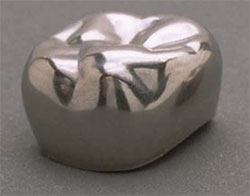 This type of crown is generally used as a temporary solution, most often in pediatric dentistry. Because primary teeth (baby teeth) are necessary for the positioning of permanent teeth, stainless steel ones are used to protect them from further decay until they fall out naturally.
This type of crown is generally used as a temporary solution, most often in pediatric dentistry. Because primary teeth (baby teeth) are necessary for the positioning of permanent teeth, stainless steel ones are used to protect them from further decay until they fall out naturally.
Metal
Commonly a gold alloy, palladium, or other base-metal alloy such as chromium or nickel, metal crowns are typically used for back molars as individuals want their metallic color to be out-of-sight. They have thinner walls, so they require less tooth reshaping and removal prior to fitting. They stand up better to chewing, rarely chip, last the longest and cause very little damage to opposing teeth.
Porcelain Fused to Metal
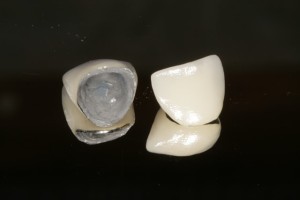 Consisting of a metal shell with a heat-fused porcelain exterior, these crowns are used for both front and back teeth since they can be color-matched and appear more natural. They are more susceptible to chipping and can cause stress or damage to opposing teeth. Sometimes the metal underneath the porcelain can be seen as a dark line near the bottom edge of the crown. If the gum recedes, it can become even more noticeable at the gum line.
Consisting of a metal shell with a heat-fused porcelain exterior, these crowns are used for both front and back teeth since they can be color-matched and appear more natural. They are more susceptible to chipping and can cause stress or damage to opposing teeth. Sometimes the metal underneath the porcelain can be seen as a dark line near the bottom edge of the crown. If the gum recedes, it can become even more noticeable at the gum line.
All-Ceramic
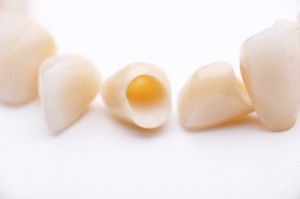 Made from a number of natural materials including types of feldspar and zirconia, all-ceramic crowns look the most lifelike as they provide a closer color match. They are also biocompatible, making them an option for those who are allergic to metal. Similar to porcelain, they are less durable and can crack or chip.
Made from a number of natural materials including types of feldspar and zirconia, all-ceramic crowns look the most lifelike as they provide a closer color match. They are also biocompatible, making them an option for those who are allergic to metal. Similar to porcelain, they are less durable and can crack or chip.
All-Resin
These are made from composite resin, most commonly acrylic polymers mixed with silicon dioxide. They are the most affordable option. The acrylics used can be color-matched to natural teeth, but they are less durable and more susceptible to fractures.
The Procedure
First Visit – Consultation
During the first visit, a dentist will examine the tooth and its root to determine whether or not a crown is a suitable method of restoration and if additional procedures will be required to make it a success. For example, a tooth with a compromised root can cause an infection or injure the tooth’s pulp, in which case a root canal might be necessary. The examination may involve analyzing X-rays and impressions of the patient’s bite. Depending on the severity or nature of the situation, the dentist may refer the patient to a specialist such as a periodontist, oral surgeon or orthodontist for further examination. Once it has been decided that capping a tooth is the best option, the dentist will proceed with preparation.
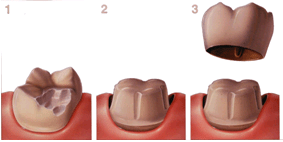
Preparation
The procedure begins by numbing the tooth with local anesthesia, followed by preparing the tooth so that it can support the crown. This includes reshaping the tooth by either filing down the enamel or applying a filling to build it up if it is too damaged or decayed. The amount removed or added depends on the type that will be used. A dental impression is taken and sent to a lab that uses it to design and manufacture it. An impression of the surrounding teeth is also taken to ensure that it perfectly integrates with your bite. A temporary crown made of acrylic is placed to protect the tooth until you return. It typically takes 2-3 weeks for it to be fabricated.
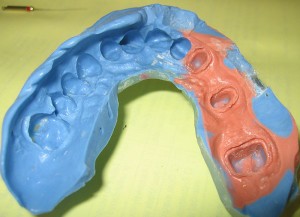
Temporary Care
Between visits it is important to take care of the temporary cap in order to protect the prep work performed underneath it. The design of the permanent crown is based on the size, shape and condition of the tooth before the temporary crown is placed, so it is important to take a few precautions. This includes avoiding sticky, chewy or hard foods that may dislodge the temporary crown, pulling floss out rather than up during cleaning to avoid pulling the crown off and chewing on the opposite side of the mouth.
Second Visit
During the second visit, the dentist will remove the temporary cap and a local anesthetic may or may not be administered. After removal, the dentist will check the fit and color before permanently cementing it in place. This is done with precision, as any gaps between the crown and the tooth can allow bacteria to grow, causing further decay and increasing the likelihood of a fracture.
The process may take more than 2 visits or require longer sessions if your situation requires special procedures such as a root canal, orthodontic treatment or gum treatment.
Recovery and Post-Procedure Care
After the procedure, patients may experience some sensitivity to hot and cold. This can be alleviated by brushing with toothpaste designed for sensitive teeth. If you experience pain or discomfort when biting down, it may not be aligned properly and another trip to the dentist is necessary. Unfortunately, crowned teeth are not decay-proof. They susceptible to fracture and gum disease just like any other tooth. Proper and consistent dental care is the best way to maintain the crown, including brushing, flossing and a healthy diet. They usually last between 5 and 15 years. The primary factors that affect how long they last are your oral hygiene and any mouth-related habits including clenching/grinding, biting fingernails and chewing ice.
Potential Problems
After the procedure, a number of problems can occur that require returning to the dentist for repairs or replacement restorations. Crowns can chip, become loose and even fall off. Usually seen in all-porcelain crowns, chipping can be repaired with composite resin. A replacement may be necessary if the damage is extensive. A crown can become loose or detach due to improper placement, a lack of cement or cement washing out from under it. These issues can usually be fixed by re-cementing it in place. If not, a new crown will be made. If the problem is ignored for too long, the underlying tooth may experience further damage, in which case the procedure must be redone.
They can take some getting used to, but crowns eventually look, feel and function just like normal teeth. If you have any concerns or questions after the procedure, contact your dentist.
References
- US National Library of Medicine. Dental crowns. – https://www.nlm.nih.gov/medlineplus/ency/article/007631.htm
- American Dental Association. Crowns. – http://www.mouthhealthy.org/en/az-topics/c/Crowns
- Academy of General Dentistry. What Are Crowns? – http://www.knowyourteeth.com/infobites/abc/article/?abc=C&iid=300&aid=1202
What to Read Next
- Find a Dentist Using Our Clinic Locator Map
- How to Much Do Dental Implants Cost?
- How to Save Money on Dental Implants
- Dental Implants vs. Bridges
- How Painful are Dental Implants?
Over to You
Have you had a tooth crowned? Has your dentist recommended you get one? Share your experience by leaving a comment!
I’m gonna get crowns for my front tooth that is discolored. Is it possible that they might get a different color?
Tamika, I’m sorry, but I’ve never heard of such a young child having crowns. I’m guessing the decay was so bad, he required them in order to eat properly and to hold place while the teeth around those develop. Unless you have $1500 or more for new crowns, he’ll probably have to live with them a few years. Eventually, he’ll grow into them or they will require replacement. The important thing is that he received the dental care he needed. Your job as a responsible Mom is to help him avoid further problems by not allowing him sugary drinks or sweets, and to get him off the bottle if he isn’t already. Hang in there!
Barry: yes, that’s a very good price. I hope you chose all-ceramic crowns which contain no metal, are more natural-looking, and cost only $25-35 more than the metal-fused crowns. I hope you’re happy with the work performed by the 2nd dentist. Take it from me, you don’t want to select a dentist based on the lowest quoted price. (My history includes 30 years of dental issues. Finally had full mouth reconstruction with ceramic crowns 6 months ago. Including a couple of root canals, I paid $26k. I carefully researched my dentist and am extremely happy with the results)
My 15 month old had to get crowns over his front two teeth because of decay. When it was done, the caps are huge! It makes him look like he has false teeth! I am very upset!!! Did I make a mistake by letting them do this? Can It be changed to look more natural?
a 15 month old? are those not just milk teeth? should you not have waited for the second permanent set to come in?
Am I getting a fair deal with my dentists? For $3481 I received full mouth x-rays, scaling for 4 quadrants, 2 rear teeth needing crowns, because of cavities, plus 1 more cavity in another tooth that was filled. I asked about implants instead, but they didn’t want to do an estimate for that. Later, the permanent crowns came in, but didn’t fit, I had a different dentist this time & everything was redone & crowns were sent back. My second pair of temporaries fell out, so I had to go back & get that redone. This time one of the temporaries is metal & I haven’t been feeling well since then. I’m waiting for my second pair of crowns to come in, which should be this week sometime 2/23 to 2/27/15. My share of the cost is $1681, Ins is $1800. I had checked out 4 other dentists before coming to this one. I guess with all dentists you have to sign up to see what you’re going to get. I’ve chosen the wrong one. One of the other 4 seems like a good candidate, so after I get my permanent crowns, I hope I can take my x-rays there.
Barry, It seems like a good deal to me. I got on this website by asking about if my dentist was or was not ripping me. I’m getting about the same amount done and it is total 2500. My insurance is picking up 600., so it’s kind of a weak policy, but it’s cheap. My co-pay is 1900. so it seems as though you might want to shop around. Or does anyone know of a better deal? I think one must also consider how good is your doctor/dentist. Is he/her gentle, kind, good attitude, good with sharp objects and how good is his hygienist/assistant ? I wouldn’t be surprised if there are dentists out there making 10 times those amounts because of their skills and personality…or, they are just professional scammers who just happen to have learned dentistry along the way. With my suspicious mind, I kind of look at all professions as potentially dishonest…that goes for doctors, dentists and especially lawyers, politicians and car salesmen. It just depends on the character of the professional and his allegiances. I’m glad you commented Barry, I learned a lot from your observations.